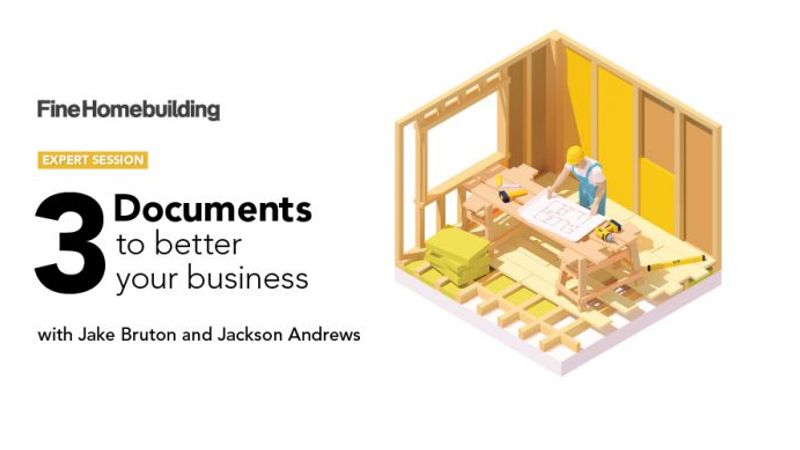Expert Session: Three Documents to Better Your Business
Builders Jake Bruton and Jackson Andrews describe and share examples of communication tools you can use to set and manage client expectations on your construction projects.

Many of us became builders and/or remodelers because we like the craft. But as much as we enjoy wearing a tool belt and solving problems on a project, we are also business owners. About five years ago, Jake came to the realization that he had to stop pretending he was a carpenter who happened to own a business and look at himself as a business owner if he wanted to protect the viability of his business and ensure he wasn’t losing money. His efforts to create a local builders’ group floundered because participants weren’t willing to talk openly with people in their market about the problems they’ve encountered in their business. We met at a trade show a few years ago and began talking about the challenges we’ve faced running our businesses—and how we’ve tried to solve them—sharing documents and processes, and opening our books to each other.
Build a strong client relationship with clear communication
We’ve both found that the most critical aspect of the business is establishing clear communications with the client, managing client expectations, and establishing accountability (in both directions) between the builder and the client. To achieve these goals, we rely on the three documents shared here; and these are, in fact, the first documents shared with clients. These documents—a Preconstruction Agreement, a Scope of Work Document, and a Construction Expectation Document—are how we vet our clients and bid our projects.
It is important that we create a transparent relationship with carefully spelled out responsibilities with our clients to support our bidding process and cost-plus con- tracts. We prefer cost-plus, because with a fixed-fee contract we would assume the risk of the bid, and to protect ourselves would then have to build a large buffer into the price. Jackson finds that as he discusses the differences between a fix-cost contract and a cost-plus contract with clients, they almost always opt for cost-plus. He explains it this way: A fix-cost contract will have a large contingency, especially in big, complex projects, and if the builder is able to do the job for less money, he gets to keep it. With a cost-plus contract, if the contingency isn’t spent, the homeowner keeps the money. Jake says the most common complaint he’ll hear about the cost-plus contract is, “Wait, it sounds like I’m giving you an open check- book.” Jake’s answer is that his advertising is all word of mouth and he really needs his customers to be happy. For both of us, a cost-plus contract means an increased level of transparency where the client sees every receipt related to their job.
Preconstruction agreement
The first document that shapes the relationship with the client is the Preconstruction Agreement. This document comes after the initial conversation with the potential client to meet them, learn about the project, and make sure their budget matches the scope of the work. The meeting to go over the preconstruction agreement sets out the general scope of work and your fees. Because so many homeowners will appear distracted during this meeting until they know the price, we present this information right up front on the first page. It’s a great way to screen the client for cost and payments right away; if they aren’t on board with our rate or payment structure, we want to know up front. This document sets the tone for the rest of the relationship and helps protect both parties by defining the responsibilities for both sides. (Download the Preconstruction Agreement example.)
Scope of work document
The preconstruction agreement also sets up the next stage of the process, which
will be encapsulated in the Scope of Work Document. We don’t do free estimates. We know that clients don’t want to hear this, and that many contractors will say, “My market won’t support a fee for estimates.” But here’s the deal: An accurate number requires a scope of work. Without a scope of work, different contractors are not bidding on the same things. But a scope of work takes time, and we have to be paid for the time to generate a complete scope of work and accurately price it. A free estimate is not the same thing; that contractor is not putting in the time and is not bidding on the same thing. Our philosophy is to get our foot in the door—have some skin in the game—and the scope of work we generate dictates how everybody else has to bid as well. An estimate is not the type of document that we’d be comfortable having a client sign, and we’d argue to a client that we should be held accountable to a greater degree than a “free estimate” allows. The scope-of-work document that we use is comprehensive, establishing the method and materials throughout the build. When we’re building this document, we have the opportunity to review with our subcontrac- tors the products and installation methods we are expecting for the project. This helps ensure we have proper trade agreements established for the agreed standards and scope of work in the beginning. (Download the Scope of Work Document example.)
Construction expectations document
Oftentimes clients have never had major remodeling done and they don’t understand the process or its potential impact on their lives. It’s important to communicate how the process will work, and how you will communicate about the process. This document is a critical part of how we manage expectations. Jackson takes a spiral-bound copy of this document on every sales call and leaves it with the potential client. By establishing the standards he wants to be held to by his clients, they have a benchmark to which they can compare other proposals and contractors. Two important areas covered in this document are establishing how you as the contractor will carve out a work-life balance for yourself and what the client’s responsibilities are to support the budget and the timeline. (Download the Construction Expectations Document example.)
These documents establishing our builder-client relationship are based on our particular experiences and the type of relationships we are trying to build. They are not static documents, and they change over time. We recommend that you take what you can from them. If these types of documents are new to your company, start small and adopt the portions that make sense to you at this point, and build on them over time. Finally, make sure you work with your attorney on the documents you use to craft the right language for your business.

























View Comments
“[Deleted]”